Chafers and Leatherjackets - The Munch Bunch!
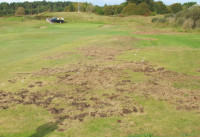
Amenity grassland and the managed amenity sector lost the use of two key pesticides last year; suddenly and with very little warning. Two active ingredients - imidacloprid and chlorpyrifos - used generally for the treatment of chafer grubs and leatherjackets respectively, were withdrawn and no chemical alternatives are likely to be forthcoming. As it currently stands, imidacloprid, the active ingredient in Merit Turf, can be used until the end of October, though it will only be available to those who had the foresight to purchase before the sales deadline elapsed.
For imidacloprid, here are the important authorisation dates:
a) 31 October 2015 for sale and distribution by the authorisation holder
b) 31 October 2016 for the disposal, storage and use of existing stocks
Chlorpyrifos authorisation ended:
a) 31 March 2016 for sale, distribution and use by any persons
b) 30 September 2016 for the disposal and storage of existing stocks by any persons
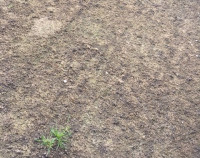
There are alternatives, and these have been used effectively for over a decade. However, it requires a revolution in the way we think about pests in turf.
Some professional users have been exploring these options for a few years, sensing increasing pressures on chemical technologies and a growing awareness that a dependence on the status quo may undermine their ability to manage future problems. The thematic strategy on the sustainable use of pesticides invokes us to explore the use of cultural, then biological controls, before ultimately deferring to chemical controls.
An article I wrote in September 2011 on Ashburnham Golf Course and their use of nematodes to effectively treat problems that they had with Chafer grubs, demonstrated a keen awareness of the need to adopt solutions that would confer long-term benefits and provide a more cost-effective solution. A recent conversation with the head greenkeeper, Paul Hopkins, confirmed that there have been no further problems - a very positive outcome.
Kington Golf Club is the highest 18-hole golf course in England. The course was designed by the highly regarded golf architect, Major Cecil Key Hutchison. It is regarded as one of the finest natural Links courses in the country. I recently spent some time with the committee at Kington Golf Course, the National Trust, who are the landowners, and their agronomist Chris Roberts. Their approach has been systematic and provides a good example of a golf club working to do the best thing for both their members and the environment.
In the past, there has been a need to apply both imidacloprid and chlorpyrifos to strategic areas of the course to control problems with chafer grubs and leatherjackets. They recognise that these pests are likely to become a significant issue in the future and have been exploring the implications of the loss of the pesticides and the use of technologies and controls that can be used going forward.
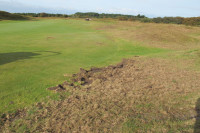
This constitutes removing thatch (un-degraded plant material) which is the foodstuff of both leatherjackets and chafer grubs. This can be done through a variety of means and each method will result in different volumes being removed over particular timescales: turf stripping will remove all of the organic matter, as will fraise mowing using a Koro Field Top Maker. Less forceful methods would be to increase aeration to encourage the organisms that are already present to degrade the thatch.
Biological control
Two methods can be employed: luring the adults away from key areas using pheromone traps, although this method is generally used as a monitoring tool to establish the size of the population and has a very limited capacity to affect a change on the population.
Alternatively, nematodes can be applied to treat infestations.
Nematodes
Nematodes are the most abundant multi-cellular organism on Earth. They are a very diverse group of animals and, although over 25,000 have been described, of which more than half are parasitic, the total number of nematode species has been estimated to be about 1 million. The simplicity of their structure has enabled them to adapt to virtually every habitat on Earth, many species are specialists living in specific ecological niches.
A small group of nematode species are parasitic on plants and some of these have gained notoriety within the sports and amenity sectors because of the problem they have caused within turf, and this has been well documented within the Pitchcare magazine.
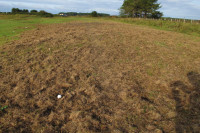
Each of the two nematode species used, Heterorhabditis bacteriophora for Chafer grubs and Steinernema feltiae for Leatherjackets, can be applied at the same time and won't disrupt each other. Both of these species are native to Britain, have been used effectively for many years, don't require any specific Personal Protective Equipment, are persistent in the soil for long-term control and are safe for users and the environment.
The nematodes are natural predators of the two grub species. When purchased, they are produced to be at an infective juvenile stage, maintained in this state by refrigeration. Once applied, they warm up and move through the soil solution, their objective being to locate and enter a suitable host, either through the skin or orifices. They then release a symbiotic bacteria which kills the host, usually within 24-48 hours.
The nematodes feed on the bacteria and host remains, and each infective juvenile develops into a hermaphroditic female. These females then produce eggs which will develop into both males and females. Only a portion of the eggs are laid outside the female; the remainder hatch inside the female and the juveniles destroy their mother as they develop. These nematodes mature, mate and produce infective juveniles that emerge from the cadaver 12-14 days after infection.
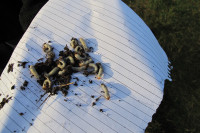
Key points to understand:
- The juveniles are kept refrigerated in a suspended state so that, when they are applied, they warm up and are actively looking for a host; however, they need to be washed off the surface and into the proximity of the larvae
- Nematodes can migrate 2-3cm per day, a pack that treats 500m2 contains 250 million nematodes, and these vast numbers artificially raise the natural population to make it an effective control
- Understanding the lifecycle of the host larvae will ensure that the nematodes are applied when they are most effective
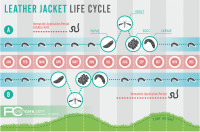
Major damage to the turf can be done by predators that are after an easy and abundant meal. Starlings, crows and other birds can congregate in vast numbers and decimate surfaces in a short period of time.
Damage to turf can be seen from September through the autumn, winter and into the spring. The lifecycle of both species means that they can pupate at two times of the year. The vast majority of Crane Flies hatch in August and September, but there is also a small number that pupate in the spring (April and May). The illustration shows the two lifecycles running concurrently:
It can be seen that the most effective time to apply nematodes to control the larvae of leatherjackets is in the autumn. This is for two reasons:
- Both lifecycles coincide, enabling a single period when both lifecycles can be effectively treated
- As the larvae become older, nearer pupation, nematodes become less able to penetrate the skin and, therefore, a greater number of nematodes are required to be as effective
It can be seen that a preventative approach is required for effective control; treatments in the early spring when symptoms of leatherjackets are evident will have limited ability.
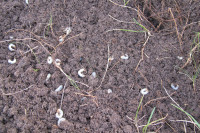
They have stout white bodies curved in a C shape, light brown heads, with three pairs of legs and darker patches at the base of the abdomen.
They are bigger than the adult beetles, although their size varies, according to species, between 8-35mm. They live within the soil for up to 3-4 years, going through various 'instars' (stages at which they moult their exoskeleton) as they develop.
Again, the real damage to turf is done by predators such as starlings, rooks, crows, jackdaws, magpies, foxes and badgers that make the most of an abundant, high protein food lying just beneath the surface.
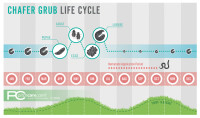
Professional application
So, how does a considered approach translate into application within the context of turf management?
Kingston Golf Course have taken an enlightened approach by consulting with the National Trust to ensure that the method they are considering satisfies the environmental concerns that they may have operating in an upland area. Areas of concern were highlighted and the following approach was adopted:
- Areas that historically have been a problem were identified
- Areas of high value, such as greens, banking around the greens, bunker surrounds and tees were identified as a priority area to be monitored
- Monitoring of populations of both invertebrates and identifying 'trigger points', at which time specified action would take place
- Targeting specific areas to remove and reduce thatch, the foodstuff of both invertebrates
- Preventative applications of nematodes to specific locations of high concern to obtain control, i.e. greens for leatherjacket control, banks for chafer grub and leatherjacket control

Biological control will become mainstream; in many forms of food production, this is already the case. Alternative products that are not registered for the purpose of controlling pest populations will appear, particularly at this point in time where there are no chemical alternatives and the mind-set of the industry is to apply a product once a problem is apparent. This has led to a reliance on chemical controls and a lazy approach to cultural control.
Ultimately, the industry will either be dragged kicking and screaming into an era where it will confront its responsibilities and deal with them in a professional manner, or individuals will pretend that they have no responsibility and continue to use products that are potentially damaging or even dangerous.
Conclusion

Undoubtedly, control of both of these major turf problems will cause concern over the next year but, by developing your knowledge of both pest and predator, the more flexible and better prepared turf managers will be able to understand how to use new technologies and provide the best managers with an opportunity to distinguish themselves. Isn't it time that we grasped the nettle and did the job properly?

